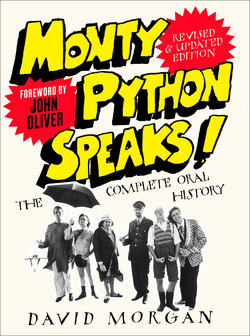Читать книгу Monty Python Speaks! Revised and Updated Edition - David Morgan - Страница 9
PRE-PYTHON IN THE OLD DAYS WE USED TO MAKE OUR OWN FUN
ОглавлениеIf there is a progenitor to credit (or blame!) for Monty Python, the innovative and surreal comedy group that turned the BBC and cinema screens on their ends, one need look no further than a tall, undisciplined, manic-depressive Irishman, born and raised in India, who spent his young adulthood playing the trumpet for British troops in North Africa, before wrestling his fervent notions of humour onto paper in the back of a London pub.
Spike Milligan, author of such pithy memoirs as Adolf Hitler – My Part in His Downfall, created the revolutionary BBC Radio series The Goon Show, which was to radio comedy what Picasso was to postcards. Aired between 1951 and 1960, and featuring Milligan, Peter Sellers, Harry Secombe, and (briefly) Michael Bentine, The Goon Show was a marvellously anarchic mixture of nonsensical characters, banterish wordplay, and weird sound effects all pitched at high speed. The surreal plots (such as they were) might concern climbing to the summit of Mt Everest from the inside, drinking the contents of Loch Lomond to recover a sunken treasure, or flying the Albert Memorial to the moon.
Milligan’s deft use of language and sound effects to create surreal mindscapes showed how the medium of radio could be used to tell stories that did not rely on straightforward plots or punchlines; it was the illogic of the character’s actions bordering on the fantastic (e.g., the hero being turned into a liquid and drunk) which moved the show along. It was a modern, dramatized version of Lewis Carroll and Edward Lear – fast-paced and hip, its language a bit blue around the edges.
The artistic and popular success of The Goon Show inspired many humourists who followed. Although its surreal nature could not really be matched, its fast-paced celebration of illogic and its penchant for satire opened the doors for some of the edgier comedy that came to light in Britain in the Sixties, such as Beyond the Fringe (an internationally successful cabaret featuring Peter Cook, Jonathan Miller, Alan Bennett, and Dudley Moore), and the television series That Was the Week That Was and The Frost Report.
But while The Goon Show demonstrated how broadcast comedy could bend convention, it was the passionate satire of the rising talents from university revues that forced satire – typically a literary exercise – into the vernacular of the day. If a map were to be drawn of the comedy universe in the late Fifties and early Sixties, its centre would assuredly comprise the halls of Cambridge and Oxford; between them, they produced a flood of talented writers and performers who were to raise the comedy standard, extending from stage to recordings, magazines, television, and film.
Among the many illustrious figures who began their careers in the Cambridge Footlights comedy troupe or in revues at Oxford were Humphrey Barclay, David Frost, Tim Brooke-Taylor, Bill Oddie, Graeme Garden, Jo Kendall, David Hatch, Jonathan Lynn, Tony Hendra, and Trevor Nunn. Also from this rich training ground came five writer/performers of deft talent: Graham Chapman, John Cleese, Eric Idle, Terry Jones, and Michael Palin – five-sixths of what would become the most successful comedy group in film and television, Monty Python.
Leading up to their first collaboration as Python in the spring of 1969, these five Cambridge/Oxford university graduates were working separately or in teams for several radio and TV shows at the BBC and at independent television (ITV) companies. They soon recognized similar tastes or aesthetics about how comedy should be written and performed. It was partly magnetism and partly luck which brought the group together, and the result was a programme that reinvented television comedy, launched a successful string of films, books, and recordings, and turned dead parrots and Spam into cherished comic icons.
